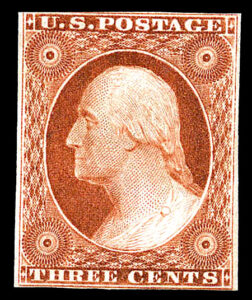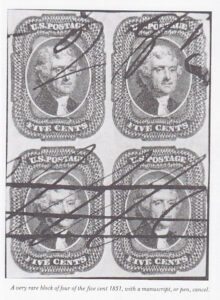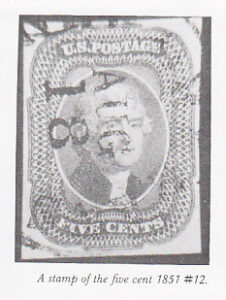
This stamp paid the common letter rate that was reduced from 5 cents to 3 cents on July 1, 1851. There are two main varieties of this stamp. The #10, known from 1851 printings of the stamp, is a shade variety. The color is described in the Scott catalogue as copper brown or orange brown (and here Scott does a far better job of color description than is often the case). The #10 has the color of a well-worn penny and came from early printings of the stamp. The #11, which comes in numerous shades itself, is every other red brown shade except copper or orange brown. This is another popular specialist stamp. Good copies of the #11 still sell for under $10, and even when unused with original gum, they don’t often top $100. So a collector could specialize in just this stamp and still send their children to college. Millions of these stamps were issued, though considerably less than that survive. The number of stamps issued of any particular design is generally known by philatelists, as over the years philatelic students have dug out the information by scanning postal records. But predicting a survival rate is considerably more difficult. In this early period, reliable estimates indicate that only a small fraction of the issued number of common rate stamps have survived and now exist in collectors’ hands. Of higher rate stamps, more were usually saved, probably because the receivers kept them as novelties.
The Five Cent 1851 (#12)
Many collectors believe this is the most beautifully engraved United States stamp. It was issued to pay the internal United Sates postage rate on letters destined for overseas. The rate included the 3 cents internal rate and a 2-cent ship letter fee. With a few exceptions, letters of this period required that postage be paid to all nations involved in its carriage, not just the originating nation, as is the case today. Accordingly, most people paid the postage to the port, and let the addressee pick up the balance. Th stamps were printed closely together—so close that copies showing all four margins are very rare. The number printed has been estimated at 150,000, so that probably fewer than 10,000 exist today in philatelists’ hands. Mint examples are rarities.


